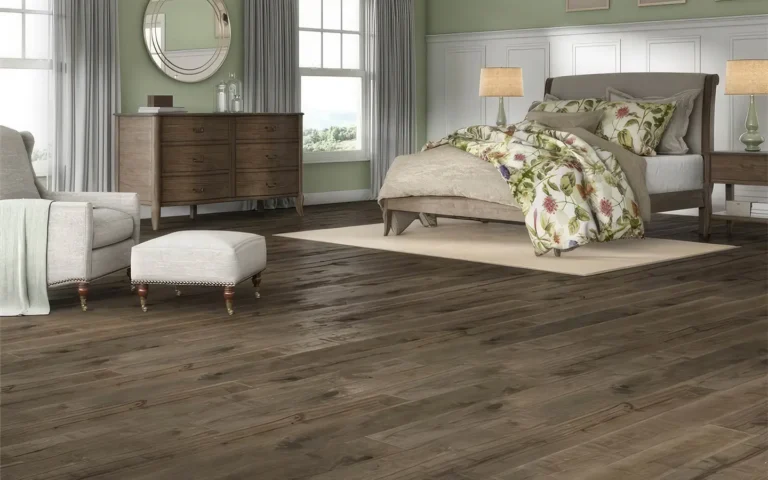Thinking about getting new floors? You’re probably looking at styles, colors, and prices, but there’s something else really important to consider: the air quality in your home. In recent years, there has been a big push to make low-VOC flooring more widely available. And we think that’s wonderful!
Whatever stage of the building process you’re in, picking a floor that won’t make you or your loved ones ill is incredibly important. Does that mean all floors that aren’t low in VOCs will make you sick? Of course not! But there are definitely some things to consider.

First of All, What Does VOC Mean, Exactly?
VOC stands for Volatile Organic Compound, a fancy term for certain chemicals released from lots of stuff we use every day. You find VOCs in things like paints, cleaning supplies, beauty products, and even that new car or fresh-out-of-the-box gadget smell – yep, that’s them!
VOCs usually don’t cause much trouble because they vanish into thin air pretty fast. And hey, one single item giving off VOCs isn’t going to turn your room into a hazard zone. But imagine your entire house’s flooring releasing these chemicals. That’s a whole different story, and it can really mess with the air quality in your home.
Why You Should Consider Low-VOC Flooring Options
When going through the process of renovation and design, choosing the right flooring is a decision that should aim to intertwine style with well-being. That’s where low-VOC flooring comes in. Unlike some traditional materials, these options don’t release a lot of harmful chemicals into your home. This means the air you and your family breathe stays cleaner.
We know health is a big deal, and you shouldn’t have to worry about your floor’s impact on your health. That’s why we’re diving into low-VOC flooring. Not only are these floors safer for your indoor air, but they also look great. We’re here to help you understand what VOCs are and why they matter, and we’ll show you some awesome eco-friendly flooring options that keep your home looking sharp and your air clean.
If you are choosing between low VOC flooring brands, look for brands that have passed California’s manufacturing and testing requirements for quality control and indoor air quality. They can all be considered non-toxic.

Best Brands of 2024
How Can VOC’s Affect Your Health
VOCs, while common in many household products, can pose significant health risks that shouldn’t be taken lightly. Exposure to these chemicals can lead to immediate symptoms like:
- Eye, nose, and throat irritation
- Headaches, loss of coordination, and nausea
- Damage to liver, kidneys, and the central nervous system
Some VOCs can cause cancer in animals, and some are suspected or known to cause cancer in humans.
The impact on your health depends on your level of exposure and the length of time you’ve been exposed. Some people, like the elderly or small children, may feel greater impacts than healthy adults. For some folks, these products can be toxic.
What Does VOC Mean When It Comes to Flooring?
When picking out new flooring, it’s good to take VOCs into consideration. You might think they’re only in things like vinyl plank because it’s made of plastic, but that’s not the whole story.
Even floors made from real wood can have VOCs. They come from stuff like the glue that holds layers of wood together or the finishes and stains that make the floor look nice and last longer. So, whether you’re looking at fancy engineered wood or even thinking about water-resistant options for your kitchen, it’s smart to check what those floors are actually made of.
But here’s a helpful tip: natural materials usually have fewer VOCs than man-made ones. Remember how we said vinyl plank floors have more VOCs? That’s because they’re synthetic. So, if you’re eyeing that synthetic carpet, maybe consider low-VOC options or switching to hardwood instead. It’s all about finding a balance between what looks good, works for your home, and keeps the air clean.
A Closer Look at Formaldehyde and Other VOC Health Hazards in Your Home
We’ve talked about low-VOC flooring, and a big part of that conversation is about formaldehyde, a common VOC that’s been labeled a probable human carcinogen by the EPA. You might wonder why it’s used if it’s harmful. The reason is its strong bonding qualities, making it a popular choice in glues and resins for various flooring materials, like vinyl and laminate.
But it’s not just formaldehyde you need to be aware of. Other VOCs, like benzene, perchloroethylene, and methylene chloride, also lurk in common household items.
Benzene: Often found in detergents, glues, and some plastics, benzene is a VOC you might encounter without even realizing it. Regular exposure can be harmful, so it’s something to keep an eye on.
Perchloroethylene: This is a mainstay in the dry cleaning industry and is used in some spot removers. While not typically a concern in flooring, it’s another common VOC in our homes.
Methylene Chloride: Commonly used in paint strippers and adhesive removers, methylene chloride is a VOC that can pose health risks, especially with frequent exposure.
Understanding these VOCs helps paint a fuller picture of indoor air quality and health, extending beyond just the realm of flooring. By being informed about what’s in the products around us, we can make healthier choices for our homes and families.
Here’s What You Need to Know About Certifications
Choosing the right low-VOC flooring can be tricky, especially with all the “green” and “eco-friendly” labels out there. But don’t worry, we’ve got you covered and know how important it is to find non-toxic materials for your home. Here’s a simple rundown of the top certifications to look for. These help make sure your flooring is really low in VOCs:
- GreenGuard: This means the flooring doesn’t give off a lot of chemicals in the air. It’s a big thumbs-up for cleaner indoor air.
- GreenGuard Gold: This is like GreenGuard but even better. It’s super strict, especially about keeping the air safe for kids and older folks.
- GreenLabel Plus: This is the one to look for if you’re looking at carpets. It shows that the carpet is low in VOCs.
- FloorScore: This is for hard floors and the glues used with them. It’s another good sign that you’re choosing something that won’t affect your air quality.
- Forest Stewardship Council (FSC): This one’s about where the wood comes from. It tells you the wood was harvested in a way that’s okay for the environment. It’s not directly about VOCs, but it’s good for peace of mind.
- California Air Resources Board (CARB): If you see this, it means the flooring meets some tough standards California set for chemical emissions. It’s especially about keeping formaldehyde levels low.
And don’t worry—looking for certified low-VOC flooring doesn’t have to be difficult. Many hardwood and engineered wood flooring options and even vinyl floors offer tons of products that are certified by some or all of these organizations.
Finding the Right Low-VOC Flooring
Choosing safe, non-toxic flooring isn’t always straightforward. It’s not just about picking a type of floor; you’ve got to dig a bit deeper. Remember those certifications we talked about? They’re your first clue in finding the right option. Keep them in mind when you shop.
Look for solid wood floors that don’t need much chemical treatment. Douglas fir and teak are good examples. The best part? Tough woods don’t need a lot of extra finishing.
Products like natural cork sheets are minimally processed and usually low in chemicals. Plus, cork has a lot of upsides and very few downsides.
Overall, High-quality, sustainable wood often doesn’t need heavy finishing to look great. It’s a choice that’s good for your home and the planet. It’s often more affordable than solid wood, but remember, it needs adhesives, which can add to the VOC count. It’s a trade-off you’ll need to consider.
Additionally, tiles are an excellent choice when it comes to low-VOC. Many tile options have minimal VOC emissions, and the recent innovation of snap-together tile flooring makes installation incredibly easy and hassle-free. This is a great route if you’re looking for durability and ease of installation. On the other hand, floating floors are another fantastic option. These types of floors don’t require adhesives and are available in a variety of easy-to-install, click-together styles
Exploring unique materials can also lead to some interesting and eco-friendly flooring choices. Have you considered hemp flooring, or maybe concrete that mimics the look of wood? These materials are not only environmentally friendly but also tend to have lower VOC levels.
Another often-overlooked option is linoleum, which is made from natural, non-toxic materials, making it a sustainable and safe choice for your home.
However, it’s important to be cautious with specialty products. For example, while products like Mohawk’s RevWood are fantastic for areas like bathrooms and mudrooms, they may not always meet low-VOC standards. So, it’s crucial to check the specifics of each product to ensure it aligns with your requirements.
Embrace Healthier Living with Low-VOC Flooring Choices
Choosing low-VOC flooring is a smart move in reducing toxin exposure in your home. While good ventilation is important, picking the right flooring plays a huge role in keeping your indoor air clean. We hope this guide has given you the insights and tools you need to make an informed decision.
Remember, there’s always more to learn about creating a healthier, more beautiful home. For additional tips and insights, be sure to explore further resources and stay informed:
About The Author

Rebecca Collett
November 6, 2020
Rebecca hails from Charleston, SC where she's refinished two homes with her husband (so far). She's addicted to the beach and seafood, but her greatest love is her family, including her husband and three sons.





